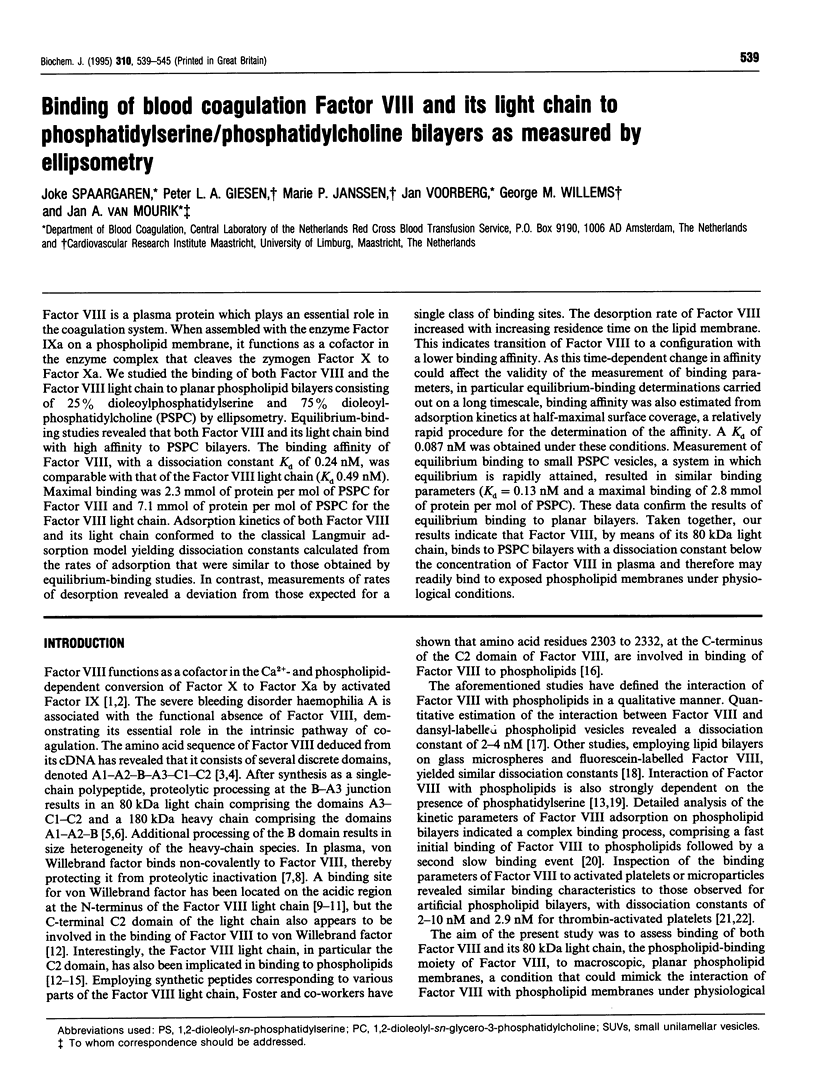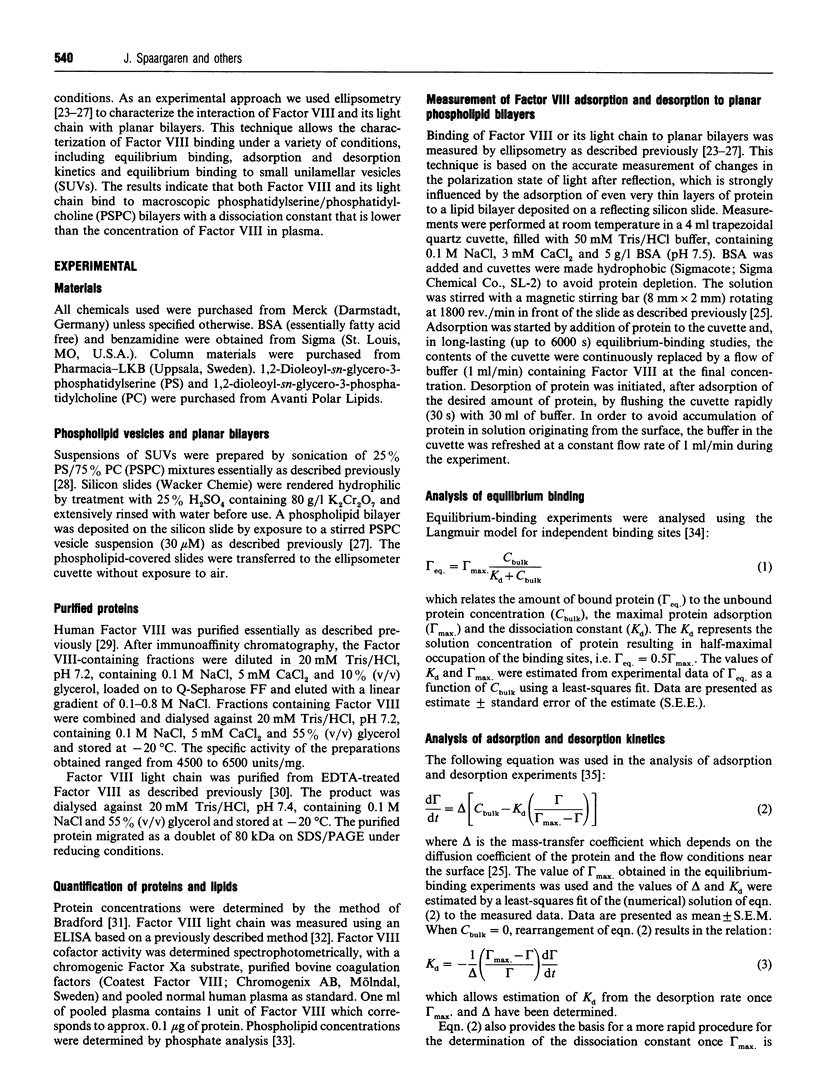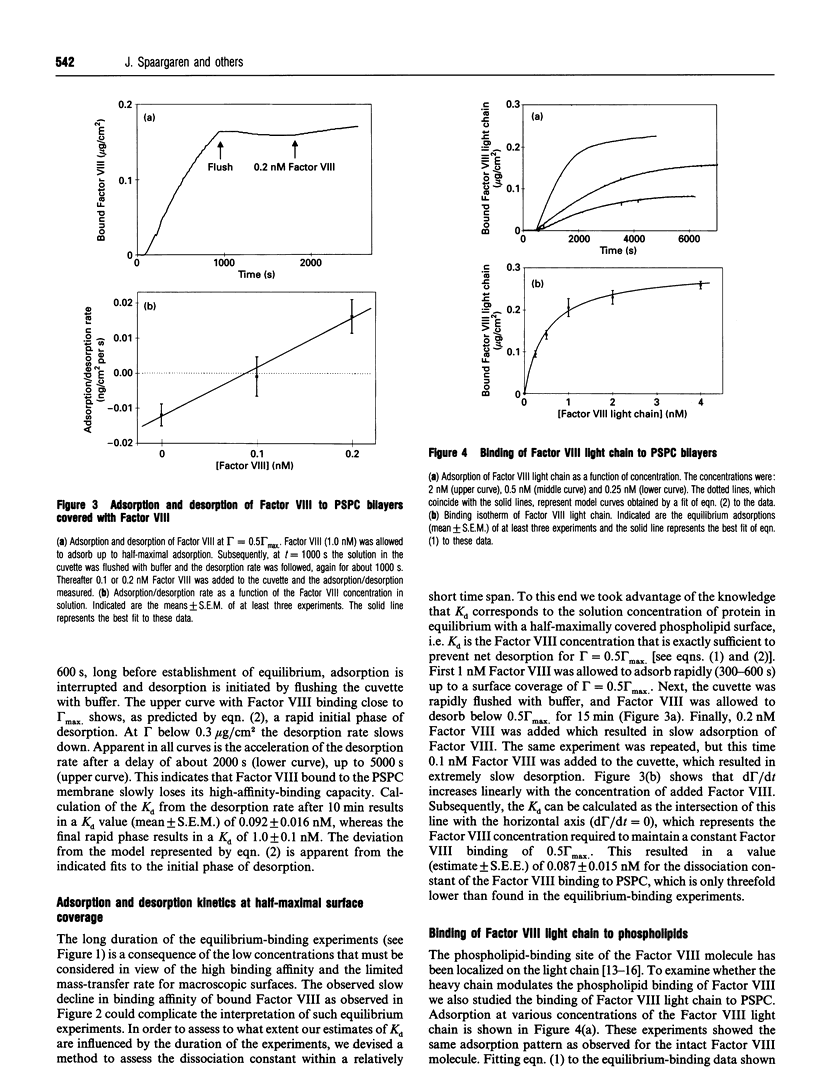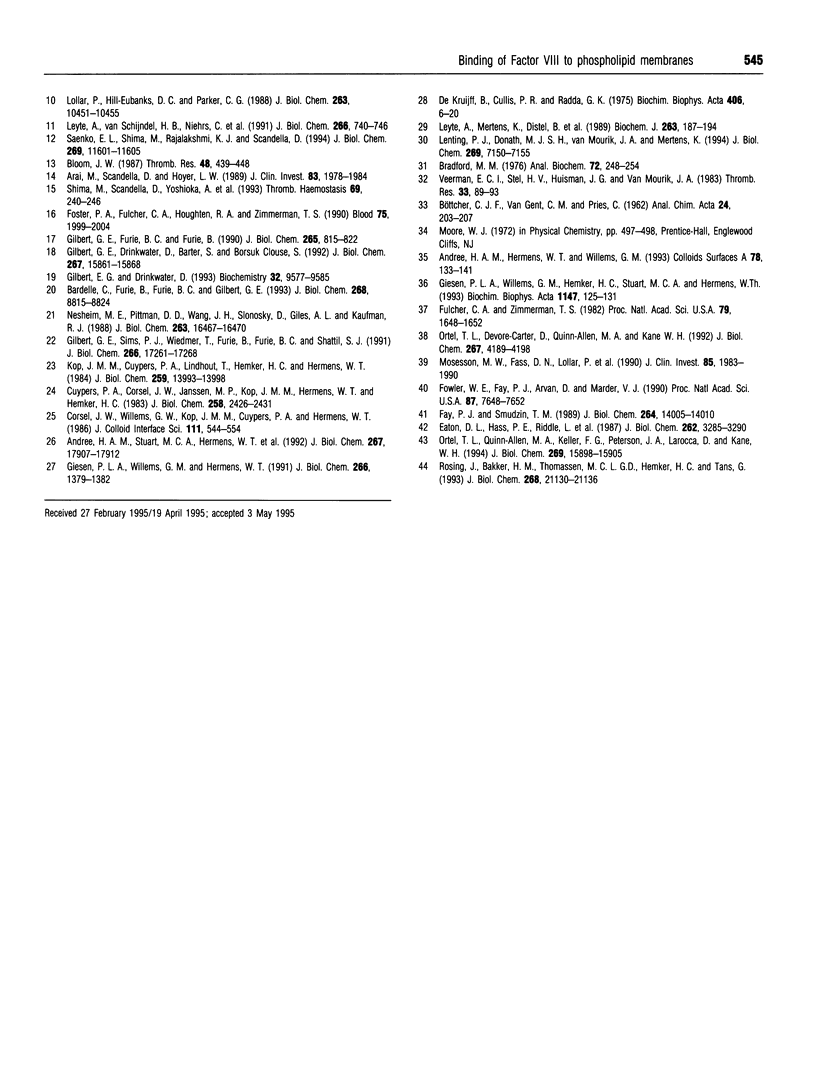Abstract
Factor VIII is a plasma protein which plays an essential role in the coagulation system. When assembled with the enzyme Factor IXa on a phospholipid membrane, it functions as a cofactor in the enzyme complex that cleaves the zymogen Factor X to Factor Xa. We studied the binding of both Factor VIII and the Factor VIII light chain to planar phospholipid bilayers consisting of 25% dioleoylphosphatidylserine and 75% dioleoylphosphatidylcholine (PSPC) by ellipsometry. Equilibrium-binding studies revealed that both Factor VIII and its light chain bind with high affinity to PSPC bilayers. The binding affinity of Factor VIII, with a dissociation constant Kd of 0.24 nM, was comparable with that of the Factor VIII light chain (Kd 0.49 nM). Maximal binding was 2.3 mmol of protein per mol of PSPC for Factor VIII and 7.1 mmol of protein per mol of PSPC for the Factor VIII light chain. Adsorption kinetics of both Factor VIII and its light chain conformed to the classical Langmuir adsorption model yielding dissociation constants calculated from the rates of adsorption that were similar to those obtained by equilibrium-binding studies. In contrast, measurements of rates of desorption revealed a deviation from those expected for a single class of binding sites. The desorption rate of Factor VIII increased with increasing residence time on the lipid membrane. This indicates transition of Factor VIII to a configuration with a lower binding affinity. As this time-dependent change in affinity could affect the validity of the measurement of binding parameters, in particular equilibrium-binding determinations carried out on a long timescale, binding affinity was also estimated from adsorption kinetics at half-maximal surface coverage, a relatively rapid procedure for the determination of the affinity. A Kd of 0.087 nM was obtained under these conditions. Measurement of equilibrium binding to small PSPC vesicles, a system in which equilibrium is rapidly attained, resulted in similar binding parameters (Kd = 0.13 nM and a maximal binding of 2.8 mmol of protein per mol of PSPC). These data confirm the results of equilibrium binding to planar bilayers. Taken together, our results indicate that Factor VIII, by means of its 80 kDa light chain, binds to PSPC bilayers with a dissociation constant below the concentration of Factor VIII in plasma and therefore may readily bind to exposed phospholipid membranes under physiological conditions.
Full text
PDF






Selected References
These references are in PubMed. This may not be the complete list of references from this article.
- Andersson L. O., Forsman N., Huang K., Larsen K., Lundin A., Pavlu B., Sandberg H., Sewerin K., Smart J. Isolation and characterization of human factor VIII: molecular forms in commercial factor VIII concentrate, cryoprecipitate, and plasma. Proc Natl Acad Sci U S A. 1986 May;83(9):2979–2983. doi: 10.1073/pnas.83.9.2979. [DOI] [PMC free article] [PubMed] [Google Scholar]
- Arai M., Scandella D., Hoyer L. W. Molecular basis of factor VIII inhibition by human antibodies. Antibodies that bind to the factor VIII light chain prevent the interaction of factor VIII with phospholipid. J Clin Invest. 1989 Jun;83(6):1978–1984. doi: 10.1172/JCI114107. [DOI] [PMC free article] [PubMed] [Google Scholar]
- Bardelle C., Furie B., Furie B. C., Gilbert G. E. Membrane binding kinetics of factor VIII indicate a complex binding process. J Biol Chem. 1993 Apr 25;268(12):8815–8824. [PubMed] [Google Scholar]
- Bloom J. W. The interaction of rDNA factor VIII, factor VIIIdes-797-1562 and factor VIIIdes-797-1562-derived peptides with phospholipid. Thromb Res. 1987 Nov 15;48(4):439–448. doi: 10.1016/0049-3848(87)90401-4. [DOI] [PubMed] [Google Scholar]
- Bradford M. M. A rapid and sensitive method for the quantitation of microgram quantities of protein utilizing the principle of protein-dye binding. Anal Biochem. 1976 May 7;72:248–254. doi: 10.1006/abio.1976.9999. [DOI] [PubMed] [Google Scholar]
- Cuypers P. A., Corsel J. W., Janssen M. P., Kop J. M., Hermens W. T., Hemker H. C. The adsorption of prothrombin to phosphatidylserine multilayers quantitated by ellipsometry. J Biol Chem. 1983 Feb 25;258(4):2426–2431. [PubMed] [Google Scholar]
- Eaton D. L., Hass P. E., Riddle L., Mather J., Wiebe M., Gregory T., Vehar G. A. Characterization of recombinant human factor VIII. J Biol Chem. 1987 Mar 5;262(7):3285–3290. [PubMed] [Google Scholar]
- Eaton D., Rodriguez H., Vehar G. A. Proteolytic processing of human factor VIII. Correlation of specific cleavages by thrombin, factor Xa, and activated protein C with activation and inactivation of factor VIII coagulant activity. Biochemistry. 1986 Jan 28;25(2):505–512. doi: 10.1021/bi00350a035. [DOI] [PubMed] [Google Scholar]
- Fay P. J., Coumans J. V., Walker F. J. von Willebrand factor mediates protection of factor VIII from activated protein C-catalyzed inactivation. J Biol Chem. 1991 Feb 5;266(4):2172–2177. [PubMed] [Google Scholar]
- Fay P. J., Smudzin T. M. Intersubunit fluorescence energy transfer in human factor VIII. J Biol Chem. 1989 Aug 25;264(24):14005–14010. [PubMed] [Google Scholar]
- Foster P. A., Fulcher C. A., Houghten R. A., Zimmerman T. S. An immunogenic region within residues Val1670-Glu1684 of the factor VIII light chain induces antibodies which inhibit binding of factor VIII to von Willebrand factor. J Biol Chem. 1988 Apr 15;263(11):5230–5234. [PubMed] [Google Scholar]
- Foster P. A., Fulcher C. A., Houghten R. A., Zimmerman T. S. Synthetic factor VIII peptides with amino acid sequences contained within the C2 domain of factor VIII inhibit factor VIII binding to phosphatidylserine. Blood. 1990 May 15;75(10):1999–2004. [PubMed] [Google Scholar]
- Fowler W. E., Fay P. J., Arvan D. S., Marder V. J. Electron microscopy of human factor V and factor VIII: correlation of morphology with domain structure and localization of factor V activation fragments. Proc Natl Acad Sci U S A. 1990 Oct;87(19):7648–7652. doi: 10.1073/pnas.87.19.7648. [DOI] [PMC free article] [PubMed] [Google Scholar]
- Giesen P. L., Willems G. M., Hemker H. C., Stuart M. C., Hermens W. T. Monitoring of unbound protein in vesicle suspensions with off-null ellipsometry. Biochim Biophys Acta. 1993 Apr 8;1147(1):125–131. doi: 10.1016/0005-2736(93)90322-q. [DOI] [PubMed] [Google Scholar]
- Gilbert G. E., Drinkwater D., Barter S., Clouse S. B. Specificity of phosphatidylserine-containing membrane binding sites for factor VIII. Studies with model membranes supported by glass microspheres (lipospheres). J Biol Chem. 1992 Aug 5;267(22):15861–15868. [PubMed] [Google Scholar]
- Gilbert G. E., Drinkwater D. Specific membrane binding of factor VIII is mediated by O-phospho-L-serine, a moiety of phosphatidylserine. Biochemistry. 1993 Sep 21;32(37):9577–9585. doi: 10.1021/bi00088a009. [DOI] [PubMed] [Google Scholar]
- Gilbert G. E., Furie B. C., Furie B. Binding of human factor VIII to phospholipid vesicles. J Biol Chem. 1990 Jan 15;265(2):815–822. [PubMed] [Google Scholar]
- Gilbert G. E., Sims P. J., Wiedmer T., Furie B., Furie B. C., Shattil S. J. Platelet-derived microparticles express high affinity receptors for factor VIII. J Biol Chem. 1991 Sep 15;266(26):17261–17268. [PubMed] [Google Scholar]
- Kane W. H., Davie E. W. Blood coagulation factors V and VIII: structural and functional similarities and their relationship to hemorrhagic and thrombotic disorders. Blood. 1988 Mar;71(3):539–555. [PubMed] [Google Scholar]
- Koedam J. A., Meijers J. C., Sixma J. J., Bouma B. N. Inactivation of human factor VIII by activated protein C. Cofactor activity of protein S and protective effect of von Willebrand factor. J Clin Invest. 1988 Oct;82(4):1236–1243. doi: 10.1172/JCI113721. [DOI] [PMC free article] [PubMed] [Google Scholar]
- Kop J. M., Cuypers P. A., Lindhout T., Hemker H. C., Hermens W. T. The adsorption of prothrombin to phospholipid monolayers quantitated by ellipsometry. J Biol Chem. 1984 Nov 25;259(22):13993–13998. [PubMed] [Google Scholar]
- Lenting P. J., Donath M. J., van Mourik J. A., Mertens K. Identification of a binding site for blood coagulation factor IXa on the light chain of human factor VIII. J Biol Chem. 1994 Mar 11;269(10):7150–7155. [PubMed] [Google Scholar]
- Leyte A., Mertens K., Distel B., Evers R. F., De Keyzer-Nellen M. J., Groenen-Van Dooren M. M., De Bruin J., Pannekoek H., Van Mourik J. A., Verbeet M. P. Inhibition of human coagulation factor VIII by monoclonal antibodies. Mapping of functional epitopes with the use of recombinant factor VIII fragments. Biochem J. 1989 Oct 1;263(1):187–194. doi: 10.1042/bj2630187. [DOI] [PMC free article] [PubMed] [Google Scholar]
- Leyte A., van Schijndel H. B., Niehrs C., Huttner W. B., Verbeet M. P., Mertens K., van Mourik J. A. Sulfation of Tyr1680 of human blood coagulation factor VIII is essential for the interaction of factor VIII with von Willebrand factor. J Biol Chem. 1991 Jan 15;266(2):740–746. [PubMed] [Google Scholar]
- Mann K. G., Nesheim M. E., Church W. R., Haley P., Krishnaswamy S. Surface-dependent reactions of the vitamin K-dependent enzyme complexes. Blood. 1990 Jul 1;76(1):1–16. [PubMed] [Google Scholar]
- Mosesson M. W., Fass D. N., Lollar P., DiOrio J. P., Parker C. G., Knutson G. J., Hainfeld J. F., Wall J. S. Structural model of porcine factor VIII and factor VIIIa molecules based on scanning transmission electron microscope (STEM) images and STEM mass analysis. J Clin Invest. 1990 Jun;85(6):1983–1990. doi: 10.1172/JCI114662. [DOI] [PMC free article] [PubMed] [Google Scholar]
- Nesheim M. E., Pittman D. D., Wang J. H., Slonosky D., Giles A. R., Kaufman R. J. The binding of 35S-labeled recombinant factor VIII to activated and unactivated human platelets. J Biol Chem. 1988 Nov 5;263(31):16467–16470. [PubMed] [Google Scholar]
- Ortel T. L., Devore-Carter D., Quinn-Allen M., Kane W. H. Deletion analysis of recombinant human factor V. Evidence for a phosphatidylserine binding site in the second C-type domain. J Biol Chem. 1992 Feb 25;267(6):4189–4198. [PubMed] [Google Scholar]
- Ortel T. L., Quinn-Allen M. A., Keller F. G., Peterson J. A., Larocca D., Kane W. H. Localization of functionally important epitopes within the second C-type domain of coagulation factor V using recombinant chimeras. J Biol Chem. 1994 Jun 3;269(22):15898–15905. [PubMed] [Google Scholar]
- Rosing J., Bakker H. M., Thomassen M. C., Hemker H. C., Tans G. Characterization of two forms of human factor Va with different cofactor activities. J Biol Chem. 1993 Oct 5;268(28):21130–21136. [PubMed] [Google Scholar]
- Saenko E. L., Shima M., Rajalakshmi K. J., Scandella D. A role for the C2 domain of factor VIII in binding to von Willebrand factor. J Biol Chem. 1994 Apr 15;269(15):11601–11605. [PubMed] [Google Scholar]
- Shima M., Scandella D., Yoshioka A., Nakai H., Tanaka I., Kamisue S., Terada S., Fukui H. A factor VIII neutralizing monoclonal antibody and a human inhibitor alloantibody recognizing epitopes in the C2 domain inhibit factor VIII binding to von Willebrand factor and to phosphatidylserine. Thromb Haemost. 1993 Mar 1;69(3):240–246. [PubMed] [Google Scholar]
- Toole J. J., Knopf J. L., Wozney J. M., Sultzman L. A., Buecker J. L., Pittman D. D., Kaufman R. J., Brown E., Shoemaker C., Orr E. C. Molecular cloning of a cDNA encoding human antihaemophilic factor. Nature. 1984 Nov 22;312(5992):342–347. doi: 10.1038/312342a0. [DOI] [PubMed] [Google Scholar]
- Veerman E. C., Stel H. V., Huisman J. G., van Mourik J. A. Application of sepharose-linked monoclonal antibodies for the immunoradiometric measurement of factor VIII-procoagulant antigen. Thromb Res. 1984 Jan 1;33(1):89–93. doi: 10.1016/0049-3848(84)90157-9. [DOI] [PubMed] [Google Scholar]
- Vehar G. A., Keyt B., Eaton D., Rodriguez H., O'Brien D. P., Rotblat F., Oppermann H., Keck R., Wood W. I., Harkins R. N. Structure of human factor VIII. Nature. 1984 Nov 22;312(5992):337–342. doi: 10.1038/312337a0. [DOI] [PubMed] [Google Scholar]
- de Kruijff B., Cullis P. R., Radda G. K. Differential scanning calorimetry and 31P NMR studies on sonicated and unsonicated phosphatidylcholine liposomes. Biochim Biophys Acta. 1975 Sep 16;406(1):6–20. doi: 10.1016/0005-2736(75)90038-3. [DOI] [PubMed] [Google Scholar]


